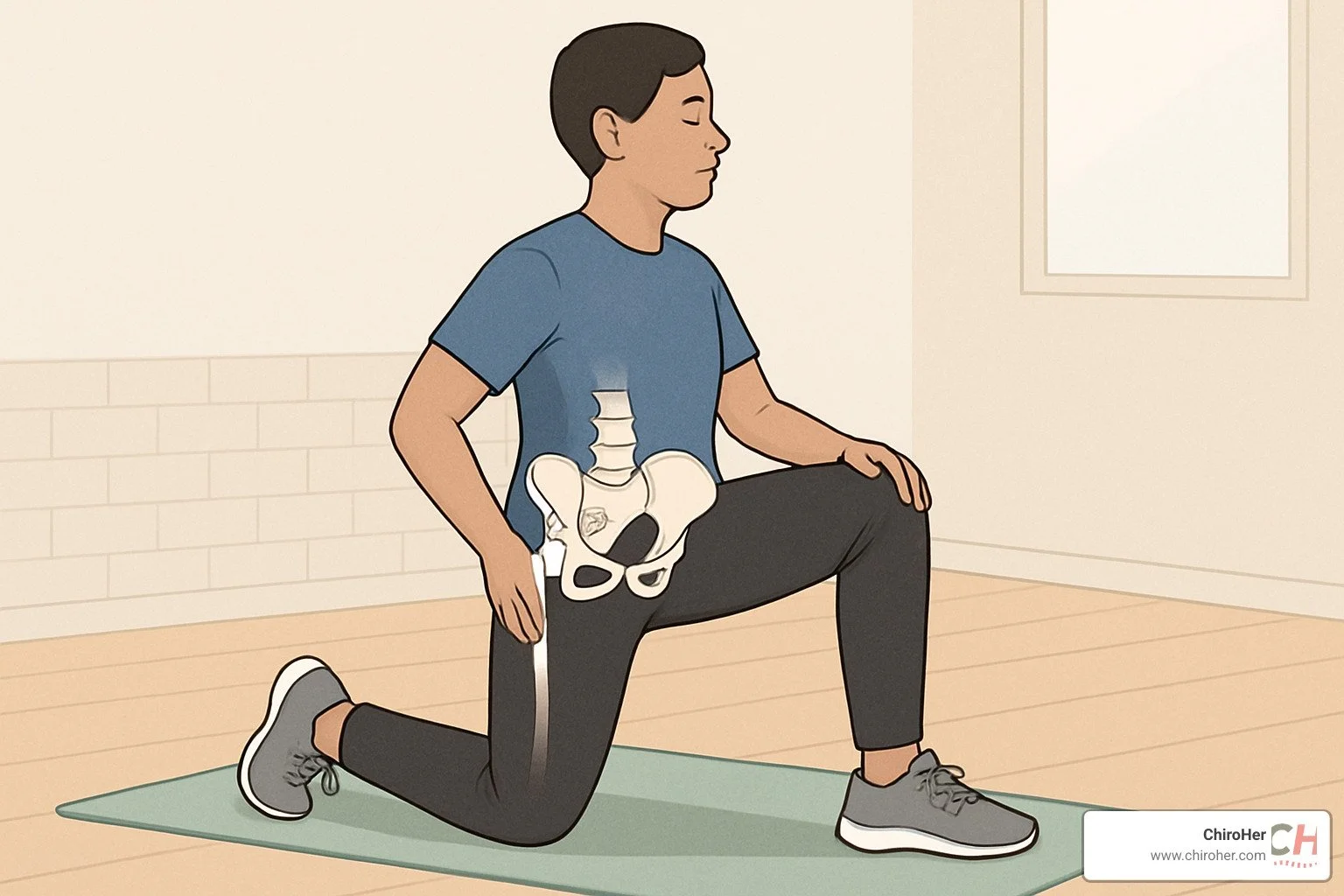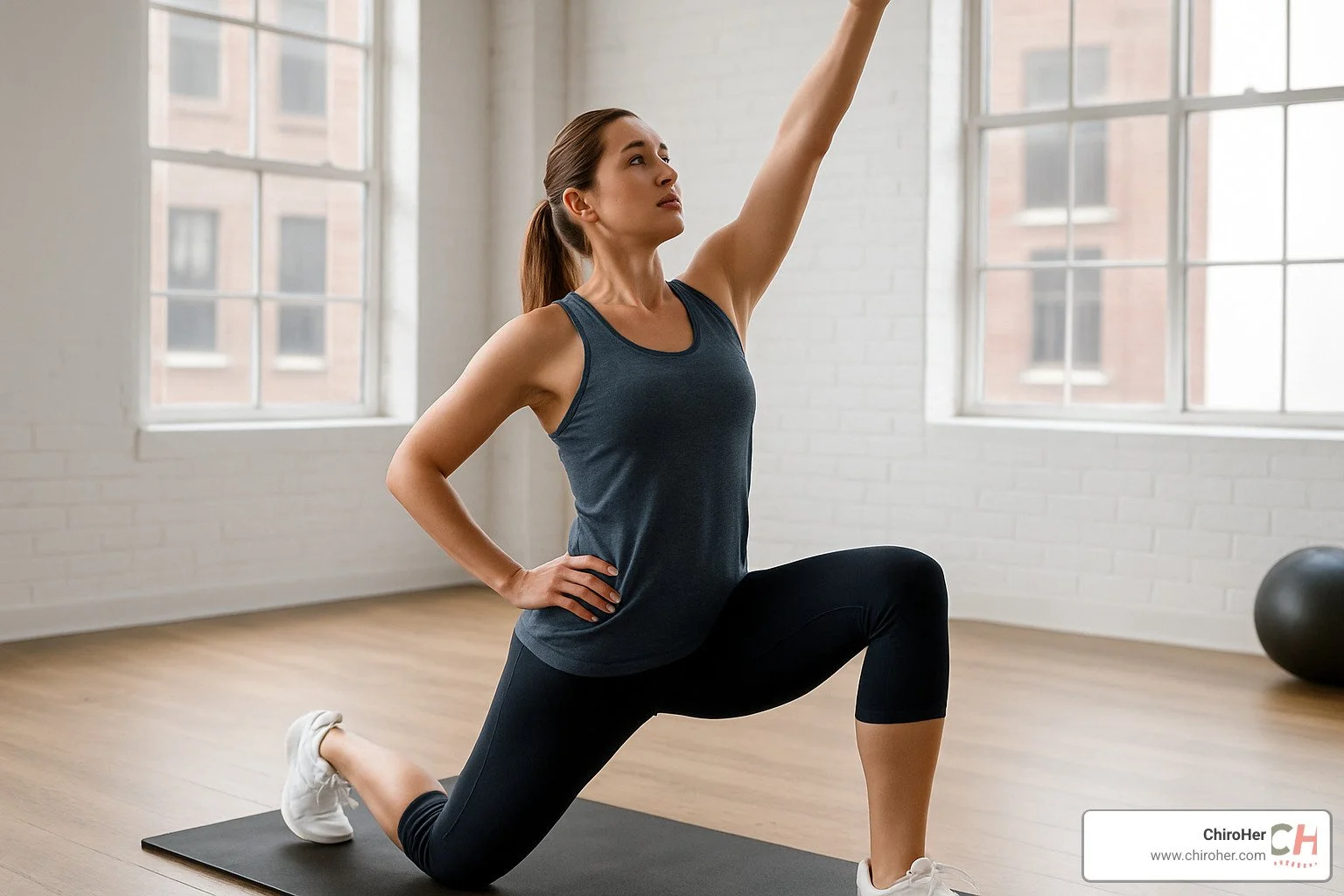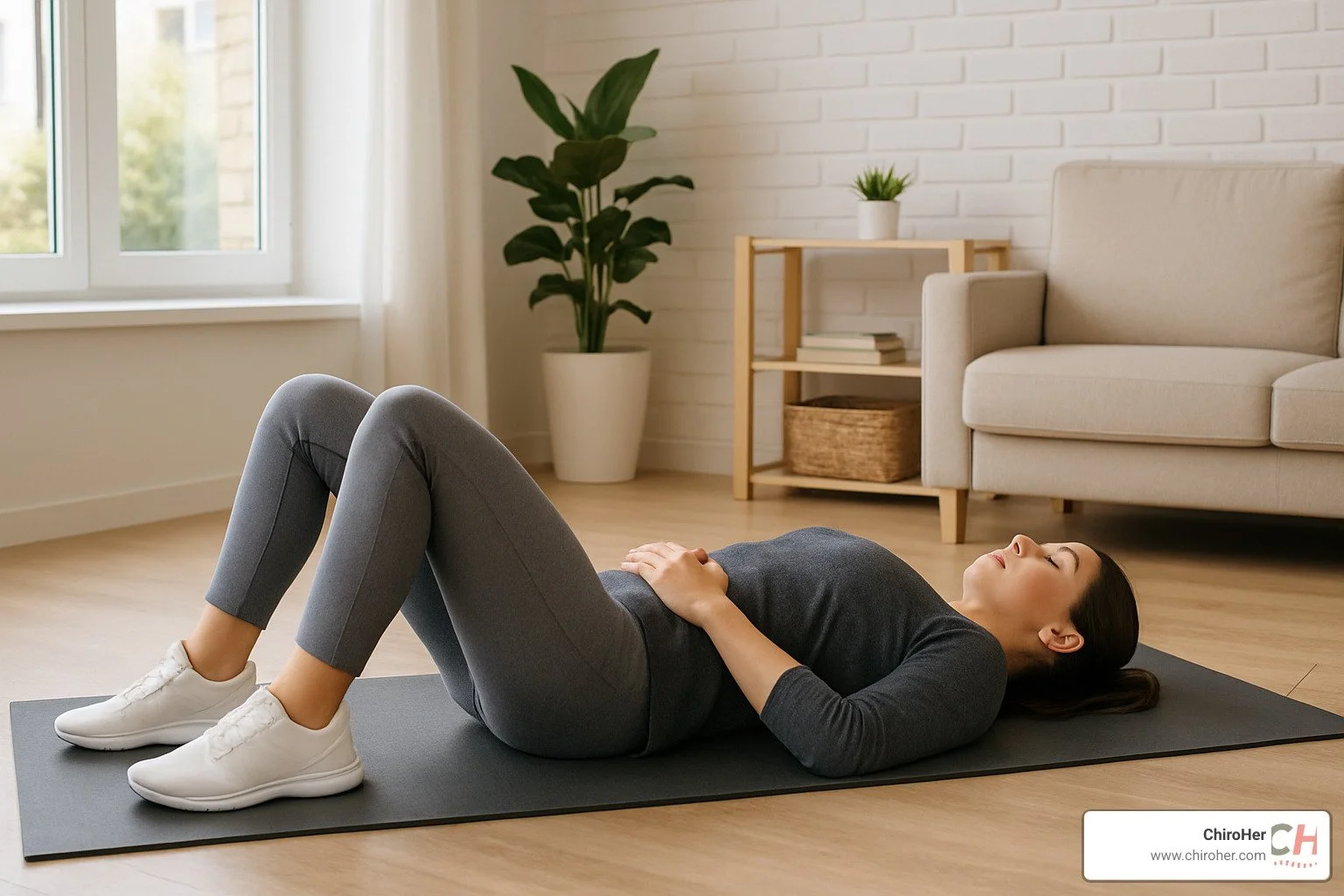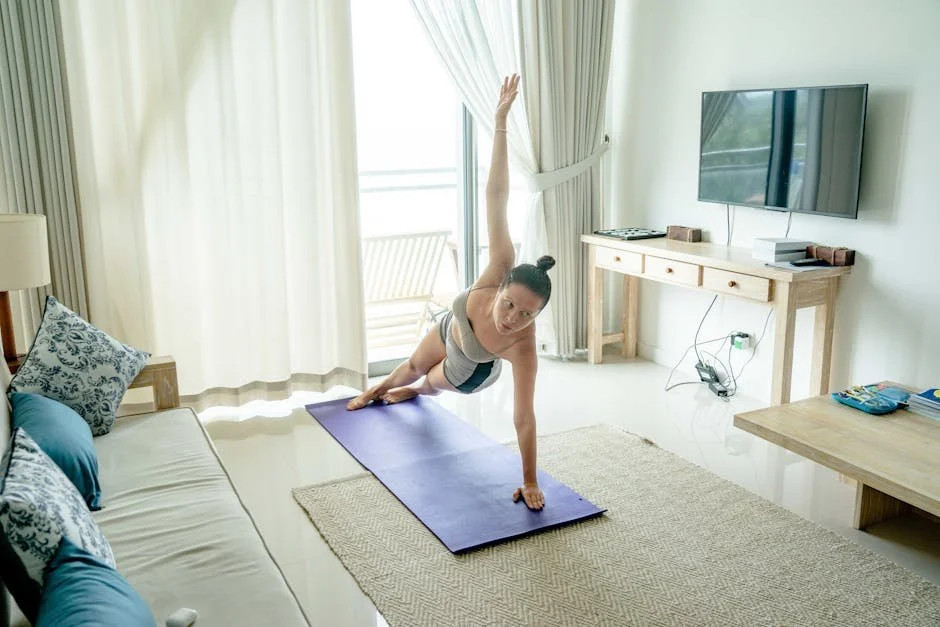Align Your Pelvis and Hips with These Stretching Exercises
Why Your Pelvis Holds the Key to Pain-Free Movement
Stretches to align pelvis are among the most effective ways to address lower back pain, hip discomfort, and postural imbalances that affect millions of busy professionals and parents. Here are the most effective stretches for pelvic alignment:
Quick Reference - Top Stretches to Align Pelvis:
Hip Flexor Lunge - 30 seconds each side, targets tight psoas
Seated Figure-4 Stretch - releases piriformis and outer hip
Pelvic Tilt Exercise - 8-12 reps to activate core muscles
Quadratus Lumborum Side Bend - corrects lateral pelvic shifts
Butterfly Stretch - opens inner thighs and hip flexors
Supine Piriformis Stretch - reduces sciatic nerve irritation
Pelvic Clock - improves mobility in all directions
Your pelvis acts as the foundation for your entire spine and connects your upper and lower body. When it's misaligned - whether tilted forward, backward, or rotated to one side - it creates a domino effect of problems throughout your body.
Research shows that hip-focused intervention programs can significantly improve strength in surrounding muscles, with gains ranging from 7% to 42% in hip abduction and 6% to 56% in hip external rotation. Studies also suggest that consistent stretching and strengthening may show significant improvement in as little as 8 weeks.
The most common culprits behind pelvic misalignment include prolonged sitting, muscle imbalances, pregnancy changes, and repetitive movement patterns. Tight hip flexors and weak glutes often create anterior pelvic tilt, while weak abdominals and tight hamstrings can contribute to posterior tilt.
I'm Dr. Michelle Andrews, founder of ChiroHer in Oklahoma City, and I've helped countless patients find relief through targeted stretches to align pelvis combined with personalized chiropractic care. My extensive training in prenatal chiropractic and sports performance has shown me how proper pelvic alignment serves as the foundation for lasting pain relief and optimal movement.
Why Pelvic Alignment Matters
Your pelvis isn't just a collection of bones - it's the central hub that connects everything from your core to your legs. When properly aligned, it provides core stability that allows you to move efficiently and powerfully.
Proper pelvic alignment improves gait efficiency, making walking and running feel more natural and less taxing on your joints. It also serves as your body's primary injury prevention system by ensuring forces are distributed evenly throughout your kinetic chain.
Understanding Pelvic Misalignment
Picture your pelvis as the foundation of your home - when it shifts or tilts, everything above it has to adjust to compensate. Pelvic misalignment happens when this crucial foundation moves away from its neutral position, creating problems that ripple throughout your entire body.
The three main types of pelvic misalignment each tell their own story. Anterior pelvic tilt occurs when your pelvis tips forward, creating an exaggerated arch in your lower back. Posterior pelvic tilt is the opposite, where your pelvis tucks under and flattens your lower back curve. Rotated pelvis occurs when one side sits higher or more forward than the other.
These misalignments don't happen overnight. Your sedentary lifestyle is often the biggest culprit - all those hours hunched over a desk gradually pull your pelvis out of alignment. Pregnancy creates its own challenges as your body adapts to carry your growing baby. Past trauma from accidents or falls can also knock your pelvis off-kilter.
The real troublemaker behind most pelvic problems? Muscle imbalances. When you sit for hours, certain muscles get tight and shortened while others become weak and stretched.
| Type | Position | Common Causes | Tight Muscles | Weak Muscles |
|---|---|---|---|---|
| Anterior Tilt | Pelvis tips forward | Prolonged sitting, pregnancy | Hip flexors, lumbar extensors | Glutes, abdominals, hamstrings |
| Posterior Tilt | Pelvis tucks under | Excessive sitting, poor posture | Hamstrings, glutes | Hip flexors, lumbar extensors |
| Rotated Pelvis | One side lifted | Leg length difference, scoliosis | Quadratus lumborum, piriformis | Gluteus medius, deep core |
Health Risks of an Unbalanced Pelvis
When your pelvis is out of alignment, your body becomes a master of compensation - but not in a good way. Lower back pain is usually the first complaint, as your lumbar spine works overtime trying to balance on an unstable foundation.
The domino effect continues with SI joint strain, hip osteoarthritis, and knee overload as your legs struggle to support a wobbly pelvis above. For women especially, pelvic floor issues become more common when the pelvis is misaligned.
Sciatic irritation is another frequent visitor, sending shooting pain down your leg when tight muscles compress the sciatic nerve. Over time, some people even develop compensatory scoliosis as their spine curves to accommodate the uneven pelvis below.
Tight & Weak Muscle Patterns
In anterior pelvic tilt, your hip flexors become chronically shortened from all that sitting. Your quadriceps and lumbar extensors also become overworked and tight.
Meanwhile, your glutes essentially go on vacation, while your abdominals stretch and weaken as your ribcage flares forward. Your hamstrings often tighten up as they try to compensate.
The gluteus medius deserves special mention - it's your lateral stability superstar. When this muscle is weak, your pelvis drops to one side with every step. The piriformis, located deep in your buttock, often becomes overactive and can compress your sciatic nerve.
Self-Checks Before You Stretch
Think of these self-checks as your personal detective work - you're gathering clues about what your pelvis is actually doing before you dive into stretches to align pelvis.
The mirror test is your first stop. Stand sideways in front of a full-length mirror in your natural posture. Look for that telltale exaggerated curve in your lower back (anterior tilt) or a flattened lower back where your pelvis tucks under.
The Thomas test is revealing. Lie on your back at the edge of a bed, pull one knee to your chest while letting the other leg hang down naturally. If that hanging leg refuses to lie flat or the thigh lifts off the surface, you've got tight hip flexors.
Don't skip the leg-length check. Lie on your back and compare where your ankles line up. Significant differences might point to pelvic rotation.
Pelvic clock awareness helps you understand how your pelvis moves. Lie on your back with knees bent and gently rock your pelvis forward, backward, and side to side. Notice which directions feel smooth and which feel restricted.
Take a moment for gait observation. Walk normally and tune into your body. Does one hip feel like it's dropping more than the other?
The smartphone photo audit is surprisingly helpful - have someone snap pictures of you from the side and back in your natural standing posture.
Red Flags to Seek Professional Help
While most pelvic alignment issues respond well to consistent stretching, some symptoms require professional attention.
Numbness or tingling in your legs could signal nerve compression. Sharp radiating pain that shoots down your leg might indicate disc problems or serious nerve irritation.
If you're in post-surgery status, especially after spinal or hip surgery, get clearance from your surgeon first. Pregnancy complications like severe pelvic pain or pubic symphysis dysfunction require specialized prenatal care.
If you've been consistently doing exercises for 6-8 weeks without improvement, it's time to call in the professionals. Sometimes underlying structural issues need hands-on assessment and treatment.
More info about what misaligned pelvis feels like can help you determine if your symptoms warrant professional evaluation.
Stretches to Align Pelvis – Core Routine
Now that you've assessed your pelvic alignment, it's time to dive into the most effective stretches to align pelvis that target your specific muscle imbalances. These seven carefully selected stretches form the foundation of our proven routine.
The hip flexor lunge stretch is a straightforward way to loosen tight muscles at the front of your hip—an area that often shortens from too much sitting. To do it, kneel on your right knee with your left foot flat in front, forming a 90-degree angle. Keep your back straight and gently press your hips forward until you feel a stretch along the front of your right hip and thigh. Hold for 30 seconds, breathing slowly, then switch sides. This stretch helps restore pelvic alignment by lengthening the hip flexors.
The kneeling psoas stretch is a powerful way to target tight hip flexors and improve pelvic alignment.
Start in a kneeling position with one knee on the ground and the other foot flat in front of you, forming a 90-degree angle.
Gently shift your hips forward until you feel a stretch in the front of your hip and thigh on the kneeling side.
Raise the arm on the same side as your back (kneeling) leg overhead.
Lean your torso slightly away from the kneeling leg to deepen the stretch along your hip flexor and psoas.
Hold for 30 seconds, breathing deeply, then switch sides.
For addressing side-to-side pelvic imbalances, try the quadratus lumborum (QL) side bend. Stand with your feet hip-width apart. Raise one arm overhead, then gently lean your torso to the opposite side, keeping your hips steady. You should feel a stretch along the side of your waist and lower back.
Seated Figure-4 Stretch
Sit tall in a sturdy chair. Cross your right ankle over your left knee, forming a "4" shape with your legs. Keep your back straight and gently lean forward from your hips, feeling a stretch in your right hip and glute. Hold, then switch sides. This stretch helps release tension in the piriformis and supports pelvic alignment.
The pelvic clock exercise builds both mobility and awareness. Lie on your back with knees bent and slowly rock your pelvis in all directions - forward, backward, and side to side.
The butterfly stretch is a simple way to loosen your inner thighs and hips. Sit tall, bring the soles of your feet together, and let your knees fall out to the sides. Hold your feet and gently draw your heels in, keeping your back straight as you lean forward slightly.
Scientific research on hip-focused stretches backs up what we see in practice - these targeted interventions really work. For a complete approach, check out our guide on stretches and exercises for misaligned pelvis.
Daily Stretches to Align Pelvis (Beginner)
If you're just starting out, let's ease into this together. Start by holding each stretch for 30 seconds and perform 2 sets of each exercise.
Focus on diaphragmatic breathing throughout each stretch. Breathe deeply into your belly, letting your breath guide you deeper into each position. Keep your neck relaxed during all stretches.
The golden rule is feeling gentle tension, never sharp pain. Consistency trumps intensity every time, so aim for your routine daily even if you can only manage 10-15 minutes.
Advanced Stretches to Align Pelvis (8-Week Progression)
Once you've mastered the basics, it's time to level up. The contract-relax method is a game-changer - contract the muscle you're stretching for 5 seconds, then relax and stretch deeper.
Try adding loaded stretches with resistance bands. The modified king dancer pose provides an excellent full-body stretch that hits multiple areas at once.
At this stage, increase your hold times to 1-2 minutes per stretch. Use mobility bands to assist with deeper ranges of motion.
Research suggests it takes around 8 weeks of consistent work to see significant improvements in pelvic alignment. Be patient with yourself and celebrate small victories.
Strengthening & Stability for Lasting Alignment
While stretching addresses tight muscles, strengthening weak muscles is equally important for lasting pelvic alignment. Muscle imbalances are often the root cause of pelvic misalignment, so we must address both sides of the equation.
Essential Strengthening Exercises:
Glute Bridges - Lie on your back with knees bent and lift your hips by squeezing your glutes. Hold for 5-10 seconds at the top. This strengthens the gluteus maximus, often weak in anterior pelvic tilt.
Clamshells - Lie on your side with knees bent and lift your top knee while keeping your feet together. This targets the gluteus medius, crucial for lateral pelvic stability.
Side-Plank Series - Start with basic side planks and progress to adding leg lifts. These exercises strengthen the entire lateral chain and improve core stability.
Bird-Dog - From hands and knees, extend opposite arm and leg while maintaining a neutral spine. This teaches core stability and proper spinal alignment.
Core Bracing - Practice engaging your deep abdominal muscles by gently drawing your belly button toward your spine while maintaining normal breathing.
For personalized strengthening programs, explore our therapeutic exercises services.
Programming Guidelines
Structure your strengthening routine around 3 sessions per week, allowing at least one day of rest between sessions. Perform 8-12 repetitions of each exercise, holding static positions for 5 seconds when applicable.
Focus on neutral spine cueing throughout all exercises. Start with bodyweight exercises and gradually add resistance as you build strength.
The mind-muscle connection is crucial - concentrate on feeling the target muscles working rather than just going through the motions. Quality of movement is always more important than quantity.
Lifestyle, Ergonomics & When to Get Help
Even the most effective stretches to align pelvis won't provide lasting results if your daily habits are working against you. If you're stretching for 20 minutes but sitting poorly for 8 hours, which do you think will have more impact?
Your desk setup is probably the biggest factor affecting your pelvic position. Position your monitor at eye level and keep your feet flat on the floor with knees at about 90 degrees - this naturally encourages a neutral pelvic position.
Lumbar support is important for maintaining the natural curve in your lower back. Whether you invest in an ergonomic chair or use a rolled-up towel, proper support prevents your pelvis from tilting backward.
Take frequent breaks every 30-45 minutes. Stand up, do a few gentle stretches, and reset your posture. Your hip flexors will thank you for the movement.
Supportive footwear affects your alignment from the ground up. High heels force your pelvis into anterior tilt and create compensations up your spine. If you must wear heels, limit the time and height.
For our expecting mothers in Oklahoma City, Yukon, Edmond, and surrounding areas, prenatal considerations become even more important. Pregnancy naturally shifts your center of gravity forward and increases the curve in your lower back.
Sometimes you need professional help. Chiropractic care becomes essential when home exercises aren't providing adequate relief. At ChiroHer, I specialize in identifying root causes through gentle, effective adjustments combined with personalized exercise programs.
Scientific research on strengthening programs shows that combined manual therapy and exercise approaches provide superior outcomes.
Maintenance Habits
The key to lasting pelvic alignment is consistency in small, daily habits that support your body's natural positioning.
Daily walks are one of the simplest yet most effective maintenance strategies. Even 10-15 minutes activates your glutes, mobilizes your hip flexors, and counteracts prolonged sitting effects.
Foam rolling helps maintain healthy tissue quality. Focus on your IT band, quadriceps, and hip flexors for 1-2 minutes each.
Your sleep posture affects alignment for 6-8 hours every night. Side sleeping with a pillow between your knees promotes better spinal alignment and reduces stress on your pelvis.
Consider a standing desk converter that allows you to alternate between sitting and standing throughout the day.
Maintain balanced training plans that don't overemphasize one movement pattern. Your pelvis thrives on balanced muscle development, not just strength in isolation.
Frequently Asked Questions about Pelvic Alignment
What symptoms suggest my pelvis is misaligned?
Your body sends clear signals when your pelvis isn't sitting quite right. Lower back pain that gets worse after sitting is often the first red flag. This ache typically improves when you move around but returns once you're back in that chair.
Hip pain or stiffness, especially when getting out of bed in the morning, is another telltale sign. You might find yourself doing that awkward shuffle for the first few steps until things "loosen up."
Take a look in the mirror from the side - does one hip appear higher than the other? Many people describe feeling "crooked" or "twisted" even when they can't put their finger on what's wrong.
Your sleep might be affected too. If you're constantly tossing and turning, unable to find a comfortable position, your pelvis might be the culprit.
Don't ignore gait changes either. That slight feeling like you're limping when you're not injured, or noticing one foot turns out more than the other, often points to pelvic misalignment.
How often should I do these stretches to align pelvis?
Consistency beats intensity every time. For the first 8 weeks - the "correction phase" - aim to do your stretches to align pelvis daily. We're talking about 15-20 minutes, not an hour-long ordeal.
Hold each stretch for 30 seconds to 2 minutes, depending on how your body feels that day. Listen to your body - it's smarter than any rigid schedule.
Strengthening exercises follow a different rhythm. Three times per week with rest days in between works best. Your muscles need time to recover and rebuild.
Research shows that some people start feeling improvements in as little as 8 weeks, while others need several months. It's better to do 15 minutes every day than an hour once a week.
Can yoga or Pilates replace these exercises?
Yoga and Pilates can be wonderful additions to your pelvic alignment routine, but they shouldn't completely replace targeted corrective work.
Both practices emphasize core strength, flexibility, and body awareness - all crucial for maintaining proper pelvic alignment. However, some yoga poses might actually make certain pelvic misalignments worse if you're not careful. Those deep backbends can push an already forward-tilted pelvis even further forward.
Pilates tends to be more universally helpful for pelvic issues because of its emphasis on neutral spine and precise core engagement.
My recommendation? Combine your targeted stretches to align pelvis with yoga or Pilates for the best of both worlds. Use the specific corrective exercises to address your particular imbalances, then enjoy yoga or Pilates for overall movement quality.
Conclusion & Next Steps
Your journey toward better pelvic alignment doesn't end here - it's just the beginning of a pain-free, more comfortable life. The stretches to align pelvis we've covered work best when they become part of your daily routine, not just something you try once or twice.
At ChiroHer, I see this every day in our Oklahoma City clinic. Patients come in feeling frustrated because they've tried everything on their own, but they're missing that personalized touch that makes all the difference.
The magic happens when you combine three key elements: targeted stretching to release tight muscles, strengthening exercises to support weak areas, and smart lifestyle changes that support your progress.
Don't get discouraged if you don't see dramatic changes in the first few weeks. Your body has been compensating for misalignment for months or even years, so it needs time to learn new patterns. Most of our patients in Yukon, Edmond, and surrounding areas start noticing real improvements around the 6-8 week mark.
Monitor your progress by paying attention to the little things - maybe you can sit through a movie without shifting around, or you wake up without that familiar lower back stiffness. These small victories add up to big changes.
Perfect alignment isn't the goal. Your body is beautifully unique, and some asymmetry is completely normal. What we're after is balanced function where you can move freely without pain holding you back.
If you've been diligent with your home routine for 6-8 weeks and still aren't seeing the relief you deserve, that's your cue to get professional help. Sometimes there are deeper issues that need hands-on treatment.
Ready to take your pelvic health to the next level? Find more about our therapeutic exercises and book your customized pelvic stability program today. At ChiroHer, we're not just treating symptoms - we're helping you build a foundation for lifelong wellness and movement freedom.
Your future self will thank you for taking action today. Let's work together to get you moving and feeling your best again.











